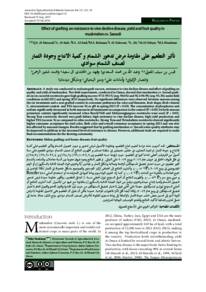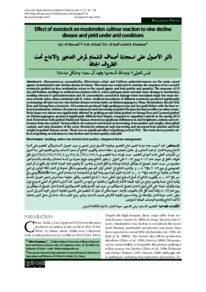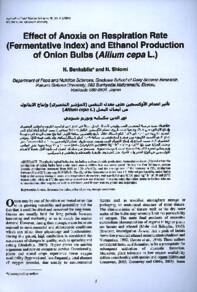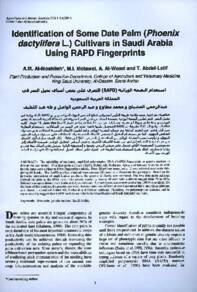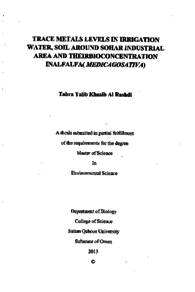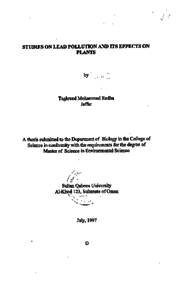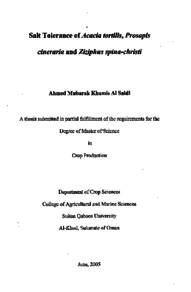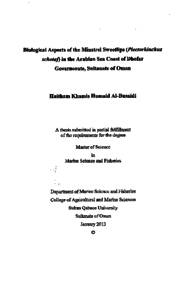Document
Effect of grafting on resistance to vine decline disease, yield and fruit quality in muskmelon cv. Sawadi.
Contributors
Publisher
Sultan Qaboos University
Gregorian
2018
Language
English
English abstract
A study was conducted to evaluate graft success, resistance to vine decline disease and effect of grafting on quality and yield of muskmelon. Two field experiments, conducted in Oman, showed that muskmelon cv. Sawadi grafted on six cucurbit rootstocks gave high grafting success: 97.6-99.1% (avg. 98.6%) and 92.4-96.9% (avg. 95.3%) under field conditions in fall 2012 and spring 2013 respectively. No significant differences were observed between seasons among the six treatments and a non-grafted control in consumer preference for odor and firmness, fruit shape, flesh vitamin C, micronutrient content and TSS (sucrose %) or pH in spring 2013 (P > 0.05). The concentration of phosphorus and sodium significantly decreased in both seasons in all treatments in comparison to the control (P > 0.05). In both seasons potassium content significantly increased when Rsscih7458 and Mubyeongjangsoo rootstocks were used (P < 0.05). Strong Tosa rootstocks showed zero graft failure, high resistance to vine decline disease, high yield production and higher TSS (sucrose %) as compared to other rootstocks. Strong Tosa and Tetsukabuto rootstocks showed significantly higher consumer acceptance for rind color, flesh color and overall consumer acceptance in spring 2013 and was also less affected by seasonal changes. Results suggested that by grafting muskmelon cv. Sawadi some quality attributes may be improved in addition to the increased level of resistance to disease. However, additional trials are required to make final recommendations for the farming community.
Member of
ISSN
2410-1079
Resource URL
Citation
Al Mawaali, Q. S., Al-Sadi, A., Al-Said, F. A., Rahman, M. S., Al-Zakwaniyah, I., Ali, A., Al-Yahyai, M., & Deadman, M. L. (2018). Effect of grafting on resistance to vine decline disease, yield and fruit quality in muskmelon cv. Sawadi. Agricultural and
Arabic abstract
لقد أجريت هذه دراسة لتقييم نجاح التطعيم، ومقاومة الأصول لمرض تدهور و موت محصول الشمام وتأثير التطعيم على كمية الإنتاج و جودة الثمار. تم تنفيذ التجارب في حقلين منفصلين في سلطنة عمان، و أظهرت النتائج أن صنف الشمام سوادي المطعوم على ستة أصول من القرعيات أعطى نجاحا كبيرا في التطعيم: حيث تراوحت نسبة التطعيم بين 97.6-99.1% (98.6%) و92.4-96.9% (95.3%) في ظل ظروف الحقل في خريف عام 2012 وربيع 2013 على التوالي. لم تظهر النتائج وجود فروق معنوية بن الستة معاملات والشاهد (الشمام الغير مطعوم) من حيث اختبار تفضيل المستهلكين للرائحة وصلابة وشكل الثمار و فيتامين C ومحتوى المواد الصلبة الذائبة (السكروز%) أو الرقم الهيدروجيني في ربيع 2013 ( P> 0.05). وأشارت النتائج إلى انخفاض تركيز الفوسفور والصوديوم بشكل ملحوظ في الثمار لكلا الموسمين في جميع المعاملات بالمقارنة مع الشاهد ( P> 0.05). كما زاد محتوى البوتاسيوم زيادة كبيرة في الثمار عندما تم استخدام أصلي 7458 Rsscihوموبي ينج سو ( P< 0.05). وأظهرت النتائج أن أصل السترنج توزاء أعطى نسبة 0% لفشل التطعيم، وأظهر مقاومة جيدة لمرض تدهور محصول الشمام وكمية إنتاج جيدة ومحتوى مرتفع من المواد الصلبة الذائبة (السكروز%) بالمقارنة مع غيره من الأصول. كما أشارت النتائج أن أصلي السترنج توزاء وتيتسوكابوتو حصلا على أعلى قبول لاختبار تفضيل المستهلكين من حيث لون القشرة واللون اللحم والقبول العام لاختبار تفضيل المستهلكين في ربيع عام 2013، وكانا أيضا أقل تأثرا بالتغيرات الموسمية. عموما يمكن أن نقول أن التطعيم على الأصول المقاومة لأمراض التربة أدى إلى تحسين بعض سمات جودة الثمار بالإضافة إلى زيادة مستوى المقاومة للأمراض لصنف الشمام سوادي. ومع ذلك، هناك حاجة إلى تعمل تجارب إضافية لتأكيد النتائج ولتقديم التوصيات النهائية للمزارعين.
Category
Journal articles

